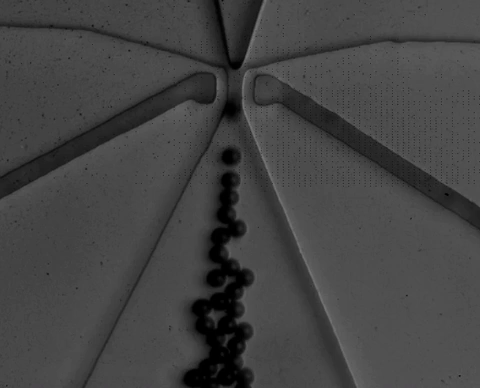
Droplet microfluidics
Microfluidics is study and manipulation of fluids on the micron length scale. Processes that would normally take several large pieces of equipment are miniaturized and combined onto a single chip. As such, microfluidic devices generally require very low volumes of fluids, decreasing the total cost of experiments and reagents and the time for analysis. In addition to advantages related to their small size, microfluidic devices also feature advantageous fluid mechanics, with the narrow channels preventing turbulent flow and thus enabling smooth and predictable transport of materials through the device via laminar flow. These advantages have led to the use of microfluidics in a variety of applications including detection, separation, small-scale chemical and micro-/nano-particle synthesis, single-cell biology, and drug delivery.

Microbubble production using a microfluidic chip
Recombinant protein-stabilized microbubbles for cancer theranostics
There has been a significant interest in developing targeted therapies for cancer treatment. Our vision is to develop a radically new protocol to detect and treat cancer using microbubbles that combine the benefits of contrast-enhanced ultrasound imaging, Microfluidics, anti vascular ultrasound therapy (AVUST) and recombinant protein technology. This collaboration among the three research groups at Penn (Lee, Hammer and Sehgal (Penn Medical)) is motivated by our recent success in generating highly uniform Microbubbles that are stabilized by recombinant protein (olefin) which imparts endless possibilities in engineering the structure and properties of Microbubbles for cancer theranostics. Our work has demonstrated that oleosin-stabilized Microbubbles are highly mono disperse, stable and echogenic, making them ideal for AVUST applications. We are currently exploring methods to tune the mechanical properties of these olefin-stabilized microbubbles and to impart targeting capabilities using recombinant protein technology.

(Top) generation of oleosin-stabilized microbubbles using a gas-valve actuated microfluidic device and (bottom) optical and fluorescence images of oleosin-stabilized microbubbles
Scale-up of microfluidic droplet generation
Microfludicis enables the generation of highly uniform emulsions with unprecedented control over their morphology, which represents new opportunities to transform various fields including materials synthesis and high-throughput biological assays. However, the translation of Droplet Microfluidics technology into the commercial scale has been limited to a very few cases. One of the main reasons we believe such translation has not been so widespread is due to the low production rate of emulsions via Microfluidic methods (<1 mL/hr). Scale-up of droplet generation to the industrial (>1L/h) scale is absolutely necessary to enable various fields to embrace the technology. To address this challenge, we have recently developed a three-dimensional monolithic elastomer device (3D MED) for mass production of mono disperse emulsion droplets. Using a method called double-sided imprinting, we can generate three dimensional micro channels a single elastomer piece that has 1000 parallel flow focusing generators. The 3D MED emanates the needs for alignment and bonding of multiple layers to make three dimensional Microfluidic channels and this makes it possible to achieve the high flow rates and pressure necessary for the large-scale production of highly uniform droplets. Using this approach, we have achieved production rates as high as 1.5 L/h (>30 billion 45 um diameter droplets per hour), with a coefficient of variation of droplet diameter of only 6.6%. Because of its simplicity and robustness, 3D MED has the potential to play a major role in bridging the gap between the continuously growing library of promising Microfluidic technologies and their successful translation in industry.

Generation of mono disperse emulsions from three-dimensional monolithic elastomer device (3D MED) with 1000 flow focusing generator
Microbubble-assisted extraction of high value added bioproducts
The biological world consists of several cells and microorganisms that contain products that could help resolve current climate and environmental waste crises. With the advancement of technology related to growing these cells in mass quantities, one of the biggest challenges is separating the bioproducts from the cells in a cost-effective manner at such quantities. Current separation schemes are time intensive batch processes that use harsh organic solvents and are often energy intensive. Seeking inspiration from nature's mantis shrimp, we work to use the shear force generated when microbubbles undergo cavitational collapse to break cell walls in a continuous manner without the need for harmful organic solvents. Using tuned ultrasound waves to find the resonant frequency of the bubbles, we can induce cavitation which can be used to rupture different types of cell walls so that encapsulated bioproducts can be extracted and recovered. We use computational modeling to analyze the dynamics of carbon dioxide microbubbles in water when exposed to ultrasound, use microfluidic design techniques to manufacture devices to fit the specifications of the modeling, and test their effectiveness at separating different types of bioproducts from cells.

Contactless, reversible droplet wetting state modulation by dielectric charge injection (DCI) for droplet-surface material interchange
Electrowetting (EW)-based technologies inform state-of-the-art platforms for droplet wetting state modulation on surfaces. However, the requirement of direct droplet-electrode contact may pose scalability challenges as droplet sizes become smaller and the number of droplets to be actuated increases. Our group develops a contactless method that is capable of modulating droplet wetting states reversibly on non-wetting substrates. The method, dubbed dielectric charge injection (DCI), involves corona discharge-based charge injection – above a critical voltage, electric field concentration around a sharp, conductive probe exceeding the surrounding medium’s dielectric strength leads to ionization of the dielectric medium. The generated ions then accelerate away from the probe due to like-polarity repulsion, leading to charge injection onto any target surface containing a reference electrode and overlaying dielectric layer. Starting from a completely non-wetting state, DCI is able to facilitate reversible wetting of the droplet, with tunable wide-range resultant contact angles. The nonwetting-wetting state reversible transition is capitalized in an application towards temporally controllable droplet-surface material interchange, which possesses utility in integrating droplet encapsulation-based technologies (e.g. microfluidics) to surface-based analytical technologies (e.g. MALDI-MS). DCI presents a contactless, reversible droplet wetting state modulation platform that builds upon the inspiring successes of EW-based technologies – simple yet powerful, with vast application potentials in digital fluidics, lenses/displays, and beyond.

